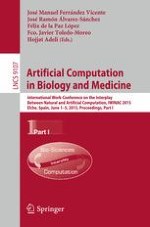2015 | Book
Artificial Computation in Biology and Medicine
International Work-Conference on the Interplay Between Natural and Artificial Computation, IWINAC 2015, Elche, Spain, June 1-5, 2015, Proceedings, Part I
Editors: José Manuel Ferrández Vicente, José Ramón Álvarez-Sánchez, Félix de la Paz López, Fco. Javier Toledo-Moreo, Hojjat Adeli
Publisher: Springer International Publishing
Book Series : Lecture Notes in Computer Science
